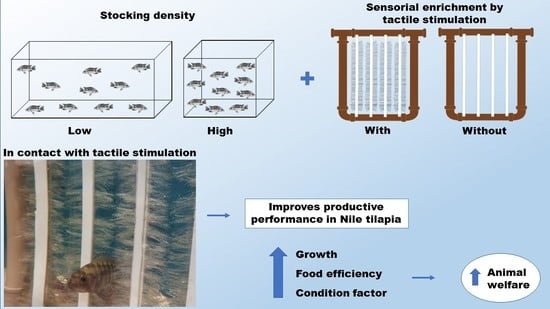
A study concludes that Tactile Stimulation enhances the productive performance of Nile tilapia aquaculture, counteracting the negative effects of high stocking density.
The use of high stocking densities in aquaculture causes stress in fish due to aggression, competition for food, water quality deterioration, among other factors, thereby affecting animal welfare and productivity.
A team of researchers from the Center for Aquaculture at UNESP (CAUNESP) and the Department of Biological Sciences at São Paulo State University (UNESP) tested the long-term effect of tactile body stimulation to alleviate the impact of high population density in Nile tilapia (Oreochromis niloticus).
Effects of high density in tilapia aquaculture
The researchers report that high stocking density is a well-known stress factor in Nile tilapia production and is associated with effects such as decreased growth and feed efficiency, reduced condition factor (K), increased cortisol levels, decreased immune capacity, increased mortality, among others.
Nile tilapia is a social fish that establishes a social hierarchy, and dominant males defend a reproductive territory through fights. Therefore, an increase in the number of individuals in an area is associated with a higher probability of fights.
Enriched environments
One strategy that has been used to improve the quality of life for fish in aquaculture systems is environmental enrichment. This involves increasing environmental complexity by adding physical structures and providing different motor or sensory stimuli.
The main goal of environmental enrichment is to provide elements to reduce maladaptation traits, trigger behavior based on the fish’s natural instincts, and satisfy their physiological, behavioral, and psychological needs, thereby improving animal welfare.
Tactile Stimulation
Tactile stimulation emerges as a sensory environmental enrichment to improve animal welfare. Several scientific studies on mammals have shown that some form of contact, petting, or “massage” promotes positive effects in animals.
In fish, researchers cite that tactile stimulation reduces stress in reef fish (Ctenochaetus striatus) and decreases aggression in male Nile tilapia. Additionally, other experiences highlight that long-term tactile stimulation reduces aggressiveness and increases productive performance in social groups of male tilapia.
Effects of tactile stimulation in tilapia
In the study, the scientists used a structure that allowed the fish to receive tactile stimulation as they passed through the bristles, thus providing not only structural but also sensory enrichment.
“In this study, we observed that long-term tactile stimulation improves the productive performance of Nile tilapia by increasing their growth, feed efficiency, and condition factor, thereby counteracting the negative effects of high stocking density,” report the scientists.
Furthermore, they point out that long-term tactile stimulation with a low stocking density showed better performance among all treatments, even though cortisol levels were higher compared to the treatment without tactile stimulation and with high density.
The researchers mention that they did not evaluate aggression in each treatment, as the number of fish per group made this analysis difficult. However, they suggest that “a possible mechanism explaining the effect of tactile stimulation on productive parameters is the reduction of aggressive interaction.”
On the other hand, the scientists describe that based on the comparison of the treatment results, they suggest that a similar amount of food can be converted into three times more weight when animals are in contact with tactile stimulation.
Conclusion
“The sensory enrichment provided by long-term tactile stimulation can be a promising tool to increase productivity in aquaculture, particularly when associated with low densities, and to counteract the negative effects of high stocking densities,” conclude the scientists.
However, they recommend conducting further research to confirm its effectiveness in tanks with a higher number of fish.
The study was funded by the National Council of Technological and Scientific Development (CNPq).
Reference (open access)
Gauy, Ana Carolina dos Santos, Marcela Cesar Bolognesi, and Eliane Gonçalves-de-Freitas. 2023. “Body Tactile Stimulation Reduces the Effects of High Stocking Density on the Welfare of Nile Tilapia (Oreochromis niloticus)” Fishes 8, no. 6: 320. https://doi.org/10.3390/fishes8060320

